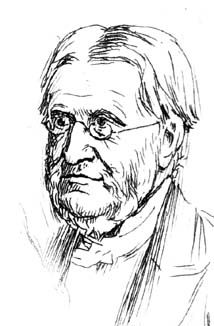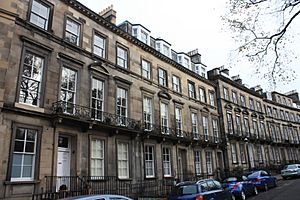Philip Kelland facts for kids
Quick facts for kids
Philip Kelland
|
|
|---|---|

Kelland, circa 1870
|
|
| Born | 17 October 1808 Dunster, Somerset, England
|
| Died | 8 May 1879 (aged 70) Allen, Stirlingshire, Scotland
|
| Nationality | English |
| Citizenship | United Kingdom of Great Britain and Ireland |
| Alma mater | Queens' College, Cambridge |
| Known for | Research on water waves Development of education in Scotland |
| Awards | Smith's Prize (1834) Keith Prize (1849–51) |
| Scientific career | |
| Fields | Mathematician |
| Institutions | University of Edinburgh |
| Academic advisors | William Hopkins |
Philip Kelland (born October 17, 1808 – died May 8, 1879) was an English mathematician. He is best known for helping to improve education in Scotland. He was also a member of important scientific groups like the Royal Society.
Contents
Early Life and Education
Philip Kelland was born in 1808 in Dunster, England. His father was also named Philip Kelland. Young Philip went to Sherborne School for his early education.
Later, he studied at Queens' College, Cambridge University. There, a mathematician named William Hopkins tutored him. In 1834, Philip Kelland finished his studies with top honors. He became a fellow at Queens' College, Cambridge, until 1838.
Important Memberships
Kelland became a member of the Royal Society in 1838. This is a very old and respected scientific group. In 1839, he also joined the Royal Society of Edinburgh. He later served as the Vice-President of the Royal Society of Edinburgh. He even became its President from 1878 to 1879. He won the Keith Medal for his work between 1849 and 1851.
Philip Kelland spent his later years living in Edinburgh, Scotland. He is buried in Warriston Cemetery in the northern part of the city.
Academic Career
In 1838, Kelland became a Professor of Mathematics at the University of Edinburgh. He took over from another famous mathematician, William Wallace. Kelland was the first English-born professor to hold this important position.
He worked with Scottish physicist James David Forbes to make universities in Scotland better. Kelland was very good at making changes to education. His colleagues respected him a lot. He was also seen as an excellent math teacher. He wrote many papers about how to improve Scottish universities.
Scientific Research
Kelland's first research was done at the University of Cambridge. He was influenced by mathematicians like Joseph Fourier and Augustin Louis Cauchy. He wrote about his early ideas in his book Theory of Heat (1837, 1842).
He published 28 papers in total. Most of these papers were about heat, light, and water waves. His work on water waves (1840, 1844) was very important. He tried to explain experiments done by John Scott Russell near Edinburgh. Even though some of his ideas had small errors, they helped other scientists. His work helped pave the way for later discoveries by George Biddell Airy and George Gabriel Stokes.
Kelland also wrote about different types of math, like General Differentiation in 1839. He also wrote about Differential Equations in 1853. He developed a new way to think about geometry called Theory of Parallels. This work was an early look into non-Euclidean geometry. He also wrote math textbooks and edited works by other scientists.
Family Life
Philip Kelland was married two times. His first wife was "Miss Pilkington." His second wife was Miss Boswall of Wardie.
See also
- Airy wave theory
- Dispersion (water waves)


